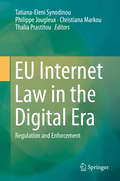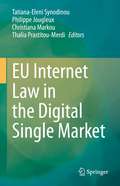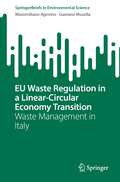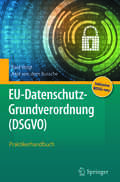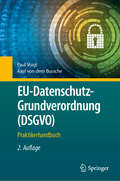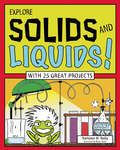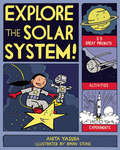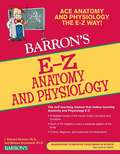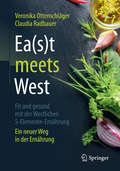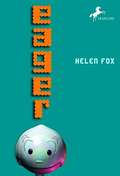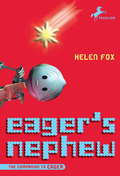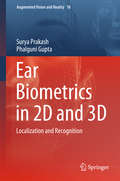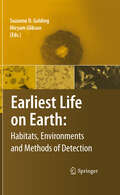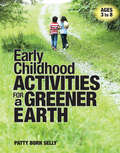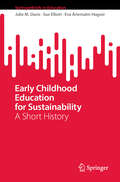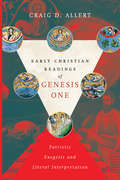- Table View
- List View
EU Internet Law in the Digital Era: Regulation and Enforcement
by Tatiana-Eleni Synodinou Philippe Jougleux Christiana Markou Thalia PrastitouThe book provides a detailed overview and analysis of important EU Internet regulatory challenges currently found in various key fields of law directly linked to the Internet such as information technology, consumer protection, personal data, e-commerce and copyright law. In addition, it aims to shed light on the content and importance of various pending legislative proposals in these fields, and of the Court of Justice of the European Union’s recent case law in connection with solving the different problems encountered. The book focuses on challenging legal questions that have not been sufficiently analyzed, while also presenting original thinking in connection with the regulation of emerging legal questions. As such, it offers an excellent reference tool for researchers, policymakers, judges, practitioners and law students with a special interest in EU Internet law and regulation.
EU Internet Law in the Digital Single Market
by Tatiana-Eleni Synodinou Philippe Jougleux Christiana Markou Thalia Prastitou-MerdiWith the ongoing evolution of the digital society challenging the boundaries of the law, new questions are arising – and new answers being given – even now, almost three decades on from the digital revolution. Written by a panel of legal specialists and edited by experts on EU Internet law, this book provides an overview of the most recent developments affecting the European Internet legal framework, specifically focusing on four current debates. Firstly, it discusses the changes in online copyright law, especially after the enactment of the new directive on the single digital market. Secondly, it analyzes the increasing significance of artificial intelligence in our daily life. The book then addresses emerging issues in EU digital law, exploring out of the box approaches in Internet law. It also presents the last cyber-criminality law trends (offenses, international instrument, behaviors), and discusses the evolution of personal data protection. Lastly, it evaluates the degree of consumer and corporate protection in the digital environment, demonstrating that now, more than ever, EU Internet law is based on a combination of copyright, civil, administrative, criminal, commercial and banking laws.
EU Waste Regulation in a Linear-Circular Economy Transition: Waste Management in Italy (SpringerBriefs in Environmental Science)
by Massimiliano Agovino Gaetano MusellaWaste management is a topical issue worldwide. In recent years, several requests have been made by citizens and associations to political decision-makers regarding the need for a significant improvement in waste management methods. Particularly considering the significant increase in awareness of social and environmental impacts and the economic consequences of non-virtuous waste management. There is growing attention on legislation and regulation's role in the waste sector. Regulation can help companies and citizens achieve a faster, more effective, and more efficient transition from a linear economy, based on the take-make-dispose paradigm, to a circular economy, in which the potential of waste as resources and secondary raw materials is exploited. This book is set in the wake of economic literature that tackles the transition from the linear to the circular economy. It focuses on the downstream stages of the waste management process (i.e. the waste treatment phase). In this regard, it is proposed a journey through the history of European waste legislation to study the waste sector's transition dynamics from a selfish and no longer sustainable economic model based on rampant consumerism to a far-sighted sustainable model addressing the well-being of future generations. Studying the changes in European waste regulations leads us to ask ourselves the following questions: how has waste collection changed in recent years? What are the new regulatory challenges that must be addressed to achieve the objectives of a circular economy? How successful has the EU legislation been in fostering the transition from a linear to a circular economy? Finally, has the European environmental legislation sprung a convergence process among European countries towards the circular economy, or has the definition of targets fuelled the already marked differences between EU countries?
EU-Datenschutz-Grundverordnung (DSGVO)
by Paul Voigt Axel von dem BusscheDieses Praktikerhandbuch enthält Hinweise zur praktischen Umsetzung der EU-Datenschutz-Grundverordnung (DSGVO) sowie eine systematische Analyse der neuen Vorschriften. Das Handbuch widmet sich unter anderem den organisatorischen und materiellen Datenschutzanforderungen, den Rechten der betroffenen Personen, der Rolle der Aufsichtsbehörden, der Rechtsdurchsetzung und den Bußgeldern nach der Verordnung, sowie nationalen Besonderheiten. Das deutsche Datenschutz-Anpassungs- und Umsetzungsgesetz EU (DSAnpUG-EU) wurde bereits umfassend berücksichtigt. Zusätzlich gewährt das Handbuch einen kompakten Überblick zu den Konsequenzen der Neuregelung für ausgewählte Verarbeitungssituationen mit hoher Praxisrelevanz, wie Cloud Computing, Big Data und Internet of Things. Die im Jahr 2016 verabschiedete DSGVO tritt im Mai 2018 in Kraft. Sie sieht zahlreiche neue bzw. verstärkte Datenschutzpflichten sowie eine deutliche Erhöhung der Bußgelder (auf bis zu 20 Mio. Euro) vor. Nicht nur in der Europäischen Union ansässige Unternehmen werden daher ihre Datenschutz-Compliance auf den Prüfstand stellen müssen; aufgrund des weiten, grenzüberschreitenden Anwendungsbereichs der Verordnung wird ihr Inkrafttreten Auswirkungen auf zahlreiche Unternehmen weltweit haben.
EU-Datenschutz-Grundverordnung (DSGVO): Praktikerhandbuch
by Paul Voigt Axel von dem BusscheDieses Praktikerhandbuch gibt einen praxisnahen Überblick über die Vorgaben der DSGVO und das deutsche Datenschutzrecht. Das Handbuch widmet sich unter anderem den organisatorischen und materiellen Datenschutzanforderungen, den Rechten der betroffenen Personen, der Rolle der Aufsichtsbehörden, den Schadensersatzanspüchen und den Bußgeldern nach der Verordnung, sowie deutschen nationalen Besonderheiten. Es enthält zahlreiche Praxishinweise und Anwendungsbeispiele sowie eine kompakte Übersicht zu den datenschutzrechtlichen Vorgaben für ausgewählte Verarbeitungssituationen mit hoher Praxisrelevanz, wie Cloud Computing, Big Data und Künstliche Intelligenz. Das Handbuch wurde für die zweite Auflage vollständig überarbeitet und berücksichtigt umfangreich neue datenschutzrechtliche Rechtsprechung und Behördenstellungnahmen.
EXPLORE ELECTRICITY!
by Carmella Van Vleet Bryan StoneGiven the pace of how we harness and utilize electricity, as well as the importance of developing new sources of energy, electricity is a timely subject for kids to explore. In Explore Electricity! With 25 Great Projects, kids ages 6-9 will learn the basics of electricity: currents, circuits, power, magnetism and electromagnetism, motors and generators. They'll become more attuned to how much they rely on electricity in their daily lives. They'll also understand that while electricity is a wonderful resource, and one we've used to our advantage ever since it was discovered, the future of how we make and use electricity is still changing and there are things they can do today to impact these changes.This title invites kids to experiment on their own with 25 simple projects that will "spark" their learning and enthusiasm, including making their own clothespin switch, lemon battery, compass, electromagnet, and flashlight, as well as generating their own "lightning." These hands-on activities combined with informational text will excite kids about STEM? the interrelated fields of science, technology, engineering, and mathematics.
EXPLORE FLIGHT!
by Bryan Stone Anita YasudaWho invented the airplane? When were airplanes invented? And why do planes have wings if the wings don't flap? Kids can answer these questions and more by jumping into the cockpit and soaring into Explore Flight! With 25 Great Projects, where they'll learn about the history of our human obsession to conquer the feat of flying.For kids ages 6-9, Explore Flight! With 25 Great Projects introduces them to the dreamers, inventors, aviation pioneers, and record breakers. They will read about the myths and legends of flying and about the wondrous flying machines of the past, present and future. They will learn that in the 15th century Leonardo da Vinci drew sketches of airplanes, helicopters and other flying machines, and that the first passengers in a hot air balloon were a sheep, a rooster, and a duck. Along the way, they will develop a better understanding of the rich history of aviation, investigate what causes flight, and learn about the science of aerodynamics. Projects and experiments range from making a paper airplane to building an airfoil. All the projects in this book are easy to follow, require little adult supervision, and use commonly found household products, many from the recycling.
EXPLORE RIVERS AND PONDS!
by Bryan Stone Carla MooneyFrom puddles to lakes, streams to rivers, and bogs to swamps, each body of water contains an amazing treasure chest of life. There is an abundance of plant and animal life hiding in every freshwater habitat. But freshwater habitats are also fragile and valuable resources that need to be protected and conserved.Explore Rivers and Ponds! with 25 Great Projects, introduces kids to the fascinating world of freshwater habitats and the creatures they contain. Combining hands-on activities with ecology and science, kids will have fun learning about the freshwater biome, including lakes and ponds, streams and rivers, and wetlands. Entertaining illustrations and fascinating sidebars illuminate the topic and bring it to life, while Words to Know highlighted and defined within the text reinforce new vocabulary. Projects include assembling an ecologist's field kit, creating a fishless aquarium, pouring casts of animal tracks, and building a watershed replica. Additional materials include a glossary, and a list of current reference works, websites, museums, and science centers.
EXPLORE SOLIDS AND LIQUIDS!
by Kathleen M. Reilly Bryan StoneFor a kid, watching a solid turn into a liquid or a liquid into a gas is nothing short of magic. In Explore Solids and Liquids! With 25 Great Projects kids experience the wonder of different states of matter. They'll learn what matter is made of, how it can change, and how these interactions really work in our universe. With plenty of activities and projects, young readers gain a solid understanding of the matter they touch, see, feel, and experience every single day.As young readers discover the basic concepts and vocabulary of chemistry, they will experiment with household objects to discover how solids, liquids, and gases occupy space. Kids will dissolve solids into liquids and bring them back again, use salt and pepper to demonstrate water's surface tension, and fly helium-filled balloons to see what happens to molecules at different temperatures. Illustrated with cartoon illustrations and filled with fun facts, Explore Solids and Liquids! makes science entertaining and exciting.Explore Solids and Liquids! meets common core state standards in language arts for reading informational text and literary nonfiction and is aligned with Next Generation Science Standards. Guided Reading Levels and Lexile measurements indicate grade level and text complexity.
EXPLORE SOLIDS AND LIQUIDS!: WITH 25 GREAT PROJECTS
by Kathleen M. Reilly Bryan StoneFor a kid, watching a solid turn into a liquid or a liquid into a gas is nothing short of magic. In Explore Solids and Liquids! With 25 Great Projects kids experience the wonder of different states of matter. They'll learn what matter is made of, how it can change, and how these interactions really work in our universe. With plenty of activities and projects, young readers gain a solid understanding of the matter they touch, see, feel, and experience every single day.As young readers discover the basic concepts and vocabulary of chemistry, they will experiment with household objects to discover how solids, liquids, and gases occupy space. Kids will dissolve solids into liquids and bring them back again, use salt and pepper to demonstrate water's surface tension, and fly helium-filled balloons to see what happens to molecules at different temperatures. Illustrated with cartoon illustrations and filled with fun facts, Explore Solids and Liquids! makes science entertaining and exciting.Explore Solids and Liquids! meets common core state standards in language arts for reading informational text and literary nonfiction and is aligned with Next Generation Science Standards. Guided Reading Levels and Lexile measurements indicate grade level and text complexity.
EXPLORE SOLIDS AND LIQUIDS!: WITH 25 GREAT PROJECTS
by Kathleen M. Reilly Bryan StoneFor a kid, watching a solid turn into a liquid or a liquid into a gas is nothing short of magic. In Explore Solids and Liquids! With 25 Great Projects kids experience the wonder of different states of matter. They'll learn what matter is made of, how it can change, and how these interactions really work in our universe. With plenty of activities and projects, young readers gain a solid understanding of the matter they touch, see, feel, and experience every single day.As young readers discover the basic concepts and vocabulary of chemistry, they will experiment with household objects to discover how solids, liquids, and gases occupy space. Kids will dissolve solids into liquids and bring them back again, use salt and pepper to demonstrate water's surface tension, and fly helium-filled balloons to see what happens to molecules at different temperatures. Illustrated with cartoon illustrations and filled with fun facts, Explore Solids and Liquids! makes science entertaining and exciting.Explore Solids and Liquids! meets common core state standards in language arts for reading informational text and literary nonfiction and is aligned with Next Generation Science Standards. Guided Reading Levels and Lexile measurements indicate grade level and text complexity.
EXPLORE THE SOLAR SYSTEM!
by Bryan Stone Anita YasudaExplore the Solar System! 25 Great Projects, Activities, Experiments introduces kids ages 6-9 to the planets, moons, and other celestial bodies that surround our star, the sun, as well as the universe beyond. Combining a hands-on element with history and science, kids investigate solar eclipses, phases of the moon, Jupiter's rings, and what astronauts wear. Who named the stars? What is the Milky Way? Why is there night? By combining a hands-on element with riddles, jokes, fun facts, and comic cartoons, kids Explore the Solar System!, and have a blast along the way.
EXTREMOPHILES as Astrobiological Models
by Joseph Seckbach Helga Stan-LotterThe data in this book are new or updated, and will serve also as Origin of Life and evolutionary studies. Endospores of bacteria have a long history of use as model organisms in astrobiology, including survival in extreme environments and interplanetary transfer of life. Numerous other bacteria as well as archaea, lichens, fungi, algae and tiny animals (tardigrades, or water bears) are now being investigated for their tolerance to extreme conditions in simulated or real space environments. Experimental results from exposure studies on the International Space Station and space probes for up to 1.5 years are presented and discussed. Suggestions for extaterrestrial energy sources are also indicated.
EZ Anatomy and Physiology, 3rd Edition (Barron's E-Z Series)
by Barbara Krunhardt Edward AlcamoA Simon & Schuster eBook. Simon & Schuster has a great book for every reader.
Ea(s)t meets West - Fit und gesund mit der Westlichen 5-Elemente-Ernährung: Ein neuer Weg in der Ernährung
by Veronika Ottenschläger Claudia RadbauerDie Kombination macht es aus – auf einzigartige Weise führt dieses Buch die jahrtausendealte Erfahrung der Traditionellen Chinesischen Medizin (TCM) mit dem Wissen der modernen Medizin und Ernährungswissenschaft zusammen. Die Idee zu diesem Buch entstand aus den gemeinsamen Kochkursen der Autorinnen. Eine einfach aufbereitete Fachliteratur für regionale und saisonale Ernährung von Ost und West war das erklärte Ziel. Ein kurzer Grundlagenteil führt zu Beginn in die Besonderheiten der beiden Ernährungsweisen ein. Der umfangreiche Warenkundeteil gliedert die Nahrungsmittel nach der TCM und unseren aktuellen wissenschaftlichen Erkenntnissen – ideal zum Nachschlagen. Viele Rezepte mit cleveren Tipps für den Alltag erleichtern die Umsetzung in die Praxis. Die Autorinnen zeigen, wie auch mit wenig Zeit köstliche, ausgewogene und kreative Gerichte gezaubert werden können. Nachhaltigkeit ist ebenso ein großes Thema. Das Buch ist für jene gedacht, die mehr über Ernährung und Gesunderhaltung erfahren und dieses Wissen ihrem Körper zuliebe anwenden möchten.
Each Woman’s Menopause: For Nurse Practitioners, Advanced Practice Nurses and Allied Health Professionals
by Patricia GeraghtyThis book is designed to meet the needs of nurse practitioners, other advanced practice nurses, and allied health professionals working in women’s health, primary care, and other specialties. The multiple roles the clinician embraces in menopause management include that of direct caregiver, manager of therapeutics, educator, and interdisciplinary team member or leader. This book provides updated, evidence based information on the menopause transition from the late reproductive stage to post-menopause to optimize the interaction of the clinician and the individual woman in each of those roles. Women’s lived experiences of menopause and women’s concerns regarding both the menopause transition and the choice of care options are included as critical components of shared therapy decisions. The review of natural menopause physiology and the variability of menopause symptoms are inclusive of diverse women and diverse trajectories. The impact of menopause on chronic disease, sleep, weight and nutrition, mood and cognition, urogenital health and sexuality, as well as vasomotor symptoms are each developed as individual topics by experts in those fields. Evidence based management using hormonal and non-hormonal options, and life-style and other complementary interventions are discussed with the most updated advantages and disadvantages of each treatment option. Consistent with advanced practice nursing theory, the approach is whole patient focused.
Eager (Eager series)
by Helen FoxIt is later this century, and the earth's natural resources have been rationed for use by technocrats. Now LifeCorp, a global company, makes all major decisions and robots do most of the work. Life otherwise is much as we know it (except that your house talks to you and the kettle asks you how many cups of tea you want). <p><p>When the Bell family's much-loved old-fashioned robot butler Grumps starts to go wrong, Mr Bell finds EGR3 through a colleague. But EGR3, known as Eager, is something different - programmed to learn through his experiences, like a human child. <p><p>He also feels wonder, excitement - and confusion; not least a sense of awe at the latest, glamorous BDC4 robots, flaunted by the families of the powerful and wealthy technocrats. And he feels sorrow at the loss of Grumps, destroyed under strange circumstances. <p><p>Then Gavin begins to think there is something odd about the BDC4s behaviour. With his sister Fleur, he investigates, enlisting Eager's help - with hilarious consequences. Questions are asked of LifeCorp and of Eager's creator and the answer to all the puzzles is finally solved. It leaves only the final question to be answered - the one closest to Eager's heart: am I alive?
Eager's Nephew
by Helen FoxIt is the future. Twenty years have passed since Eager' s first adventures with the Bell family. Scientists are now banned from building robots that can think for themselves and feel emotion, like Eager. He and other robots have spent years in hiding. But Eager secretly visits the Bell family, and his headstrong nephew, a most unusual new robot named Jonquil, stows away on the visit. They arrive at the Bells just in time— for mysterious and dangerous things are happening to the family and their friends. Eager and Jonquil' s special abilities could save the day. The human world is totally new to Jonquil, who can' t always tell fact from fiction. Excitable Jonquil is in his element. When he isn' t in danger himself, he' s causing havoc for everyone else. . . . "From the Hardcover edition. "
Ear Biometrics in 2D and 3D
by Surya Prakash Phalguni GuptaThis book presents the state-of-the-art techniques and recent research progress on Ear Biometrics. Among the various physiological traits, the reasons for the ear to gain much attention in recent years are many folds. It has been found to be a reliable biometrics for human verification and identification. Ears are remarkably consistent and unlike face, it does not change shape with different expressions or age, and remain fixed in the middle of the side of the head against a predictable background. The book contains figures, tables and plots to illustrate the techniques in an easy and lucid manner. The book also provides an extensive literature on the subject, where readers have the benefit of receiving all the relevant material at one place in a very comprehensive manner. This book caters students, academics, researchers, practitioners who are interested in the field of Ear Biometrics and its applications in face recognition and security.
Earliest Life on Earth: Habitats, Environments and Methods of Detection
by Suzanne D. Golding Miryam GliksonThis volume integrates the latest findings on earliest life forms, identified and characterised in some of the oldest rocks on Earth. New material from prominent researchers in the field is presented and evaluated in the context of previous work. Emphasis is placed on the integration of analytical methods with observational techniques and experimental simulations. The opening section focuses on submarine hot springs that the majority of researchers postulates served as the cradle of life on Earth. In subsequent sections, evidence for life in strongly metamorphosed rocks such as those in Greenland is evaluated and early ecosystems identified in the well preserved Barberton and Pilbara successions in Southern Africa and Western Australia. The final section includes a number of contributions from authors with alternate perspectives on the evidence and record of early life on Earth. Audience This volume will be valuable to researchers and graduate students in biogeosciences, geochemistry, paleontology and geology interested in the origin of life on earth.
Early Childhood Activities for a Greener Earth
by Patty Born SellyMore than 100 classroom activities to help children learn about and care for the earthEducate young children about the environment through experience and play. These activities encourage children to develop a sense of wonder, curiosity, and joy for nature. Each chapter focuses on a common and important environmental topic-from waste reduction and recycling to air quality, weather and climate change, and energy reduction-and provides information to help you present these topics to children in developmentally appropriate ways. Early Childhood Activities for a Greener Earth will help you excite children, engage families, and encourage your community to be green.Early Childhood Activities for a Greener Earth is a 2014 Teachers' Choice Award for the Classroom winner!
Early Childhood Education for Sustainability: A Short History (SpringerBriefs in Education)
by Julie M. Davis Sue Elliott Eva Ärlemalm-HagsérThis book presents an historical and contemporary overview of Early Childhood Education for Sustainability (ECEfS). It is written by pioneering Australian and Swedish researchers and includes commentary from other key academics in the field. It traces ECEfS from its 1980’s origins through to contemporary shifts in policy, theory and practice, and considers significant learnings and future directions. It frames this rich and diverse history through changes in thinking about children, educators, nature/environment dualities and sustainability, and how (re)conceptualisations might further advance ECEfS. This book offers fresh perspectives on how sustainability and climate change can be positively addressed with, by, and for our youngest citizens, especially in times of increasing uncertainty, destabilisation, and urgency for action.
Early Christian Readings of Genesis One: Patristic Exegesis and Literal Interpretation (Biologos Books on Science and Christianity)
by Craig D. AllertDo the writings of the church fathers support a literalist interpretation of Genesis 1? Young earth creationists have maintained that they do. And it is sensible to look to the Fathers as a check against our modern biases. But before enlisting the Fathers as ammunition in our contemporary Christian debates over creation and evolution, some cautions are in order. Are we correctly representing the Fathers and their concerns? Was Basil, for instance, advocating a literal interpretation in the modern sense? How can we avoid flattening the Fathers' thinking into an indexed source book in our quest for establishing their significance for contemporary Christianity? Craig Allert notes the abuses of patristic texts and introduces the Fathers within their ancient context, since the patristic writings require careful interpretation in their own setting. What can we learn from a Basil or Theophilus, an Ephrem or Augustine, as they meditate and expound on themes in Genesis 1? How were they speaking to their own culture and the questions of their day? Might they actually have something to teach us about listening carefully to Scripture as we wrestle with the great axial questions of our own day? Allert's study prods us to consider whether contemporary evangelicals, laudably seeking to be faithful to Scripture, may in fact be more bound to modernity in our reading of Genesis 1 than we realize. Here is a book that resets our understanding of early Christian interpretation and the contemporary conversation about Genesis 1.
Early Computing in Britain: Ferranti Ltd. and Government Funding, 1948 — 1958 (History of Computing)
by Simon LavingtonThis unique book presents the story of the pioneering manufacturing company Ferranti Ltd. – producer of the first commercially-available computers – and of the nine end-user organisations who purchased these machines with government help in the period 1951 to 1957. The text presents personal reminiscences from many of the diverse engineers, programmers and marketing staff who contributed to this important episode in the emergence of modern computers, further illustrated by numerous historical photographs. Considerable technical details are also supplied in the appendices.Topics and features: provides the historical background to the Ferranti Mark I, including the contributions of von Neumann and Turing, and the prototype known as The Baby; describes the transfer of technologies from academia to industry and the establishment of Ferranti’s computer production resources; reviews Ferranti’s efforts to adapt their computers for sale to business and commercial markets, and to introduce competitive new products; covers the use of early Ferranti computers for defence applications in different government establishments in the UK, including GCHQ Cheltenham; discusses the installation and applications of Ferranti computers at universities in the UK, Canada, and Italy; presents the story of the purchase of a Ferranti Mark I* machine by the Amsterdam Laboratories of the Shell company; details the use of Ferranti Mark I* computers in the UK’s aerospace industry and compares this with the American scene; relates the saga of Ferranti’s journey from its initial success as the first and largest British computer manufacturer to its decline and eventual bankruptcy.This highly readable text/reference will greatly appeal to professionals interested in the practical development of early computers, as well as to specialists in computer history seeking technical material not readily available elsewhere. The educated general reader will also find much to enjoy in the photographs and personal anecdotes that provide an accessible insight into the early days of computing.
Early Creationist Journals
by Ronald L. NumbersOriginally published in 1995, Early Creationist Journals is the ninth volume in the Creationism in Twentieth-Century America series, reissued in 2021. The book is a concise primary source collection containing a selection of journal articles from the early twentieth century outlining discoveries in biology, geology, physiology and archaeology and their relation to Christianity. The aim of the journals was to provide a platform for creationists of the 1920s to voice their theories on new science and how more recent discoveries fit within creationist beliefs, including flood theory. These interesting and unique journals will be of interest to academics working in the field of religion and natural history and provide a unique snapshot into the debates between evolutionists and Christianity during a period of great scientific change.
